

Actinidia deliciosa var. chlorocarpa (Kiwifruit var. chlorocarpa. Kiwifruit. Packed with more vitamin C than an equivalent amount of orange, the bright green flesh of the kiwifruit speckled with tiny black seeds adds a dramatic tropical flair to any fruit salad.
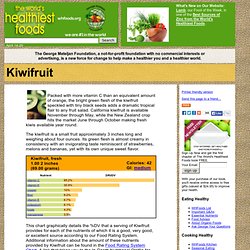
California kiwifruit is available November through May, while the New Zealand crop hits the market June through October making fresh kiwis available year round. The kiwifruit is a small fruit approximately 3 inches long and weighing about four ounces. Its green flesh is almost creamy in consistency with an invigorating taste reminiscent of strawberries, melons and bananas, yet with its own unique sweet flavor. Kiwifruit, fresh1.00 2 inches(69.00 grams) NutrientDRI/DV This chart graphically details the %DV that a serving of Kiwifruit provides for each of the nutrients of which it is a good, very good, or excellent source according to our Food Rating System. Health Benefits Kiwifruit can offer a great deal more than an exotic tropical flair in your fruit salad. Kiwi's Phytonutrients Protect DNA Description. California Kiwifruit Commission. Nutrition Facts and Analysis for Kiwi fruit, (chinese gooseberries), fresh, raw.
Zespri ® Kiwifruit industry in New Zealand. A kiwifruit orchard in the North Island of New Zealand.

Kiwifruit is a major horticultural export earner in New Zealand. New Zealand is the second largest kiwifruit producing country, next to Italy,[1] and holds approximately 30% of the market share. In the 2008-2009 season the value New Zealand kiwifruit exports was NZ$1.45 billion.[2] Kiwifruit is native to the Yangtze River valley on the coast of Eastern China. The New Zealand Kiwifruit industry began with Mary Isabel Fraser, a teacher and missionary, bringing kiwifruit seeds to New Zealand from China in 1904.[3][4] A New Zealand horticulturalist, Hayward Wright, developed the well-known green kiwifruit in Avondale, New Zealand, around 1924. Origin of the Fruit[edit] Origins of the Industry[edit] The first commercial planting of Chinese gooseberries occurred in 1937 by the orchardist Jim MacLoughlin.
Plant Name Details. Data Use Agreement - GBIF Portal. Background The goals and principles of making biodiversity data openly and universally available have been defined in the Memorandum of Understanding on GBIF, paragraph 8 (see the relevant excerpts in the attached Annex).
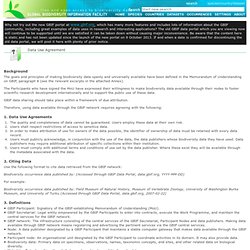
The Participants who have signed the MoU have expressed their willingness to make biodiversity data available through their nodes to foster scientific research development internationally and to support the public use of these data. GBIF data sharing should take place within a framework of due attribution. Therefore, using data available through the GBIF network requires agreeing with the following: 1. The quality and completeness of data cannot be guaranteed. 2. Use the following format to cite data retrieved from the GBIF network: Biodiversity occurrence data published by: (Accessed through GBIF Data Portal, data.gbif.org, YYYY-MM-DD) For example: 3. GBIF Participant: Signatory of the GBIF-establishing Memorandum of Understanding (MoU). Actinidia deliciosa GOLD CARD. Actinidia deliciosa GOLD CARD. Kiwi Fruit - Kiwifruit Facts, Nutrition Data and Health Benefits.
Kiwifruit. Kiwifruit by species A = A. arguta, C = A. chinensis, D = A. deliciosa, E = A. eriantha, I = A. indochinensis, P = A. polygama, S = A. setosa.
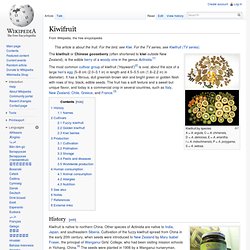
The kiwifruit or Chinese gooseberry (often shortened to kiwi outside New Zealand), is the edible berry of a woody vine in the genus Actinidia.[1] History[edit] Kiwifruit is native to northern China. Other species of Actinidia are native to India, Japan, and southeastern Siberia. Cultivation of the fuzzy kiwifruit spread from China in the early 20th century, when seeds were introduced to New Zealand by Mary Isabel Fraser, the principal of Wanganui Girls' College, who had been visiting mission schools in Yichang, China.[4] The seeds were planted in 1906 by a Wanganui nurseryman, Alexander Allison, with the vines first fruiting in 1910.
Actinidia deliciosa. Actinidia deliciosa, Fuzzy Kiwifruit or mangüeyo is a fruiting vine native to southern China, the fruit of which has been declared the national fruit of that country.
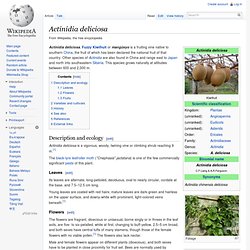
Other species of Actinidia are also found in China and range east to Japan and north into southeastern Siberia. This species grows naturally at altitudes between 600 and 2,000 m. Description and ecology[edit] Actinidia deliciosa is a vigorous, woody, twining vine or climbing shrub reaching 9 m.[1] Leaves[edit] Foliage Its leaves are alternate, long-petioled, deciduous, oval to nearly circular, cordate at the base, and 7.5–12.5 cm long. Young leaves are coated with red hairs; mature leaves are dark-green and hairless on the upper surface, and downy-white with prominent, light-colored veins beneath.[1] Flowers[edit] Actinidia deliciosa. Actinidia deliciosa [edit] Classification System: APG III (down to family level) Main Page Regnum: Plantae Cladus: Angiosperms Cladus: Eudicots Cladus: Core eudicots Cladus: Asterids Ordo: Ericales Familia: Actinidiaceae Genus: Actinidia Secies: A. deliciosa Name[edit]
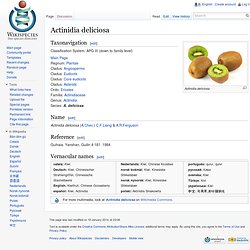
Actinidia deliciosa (Kiwi)